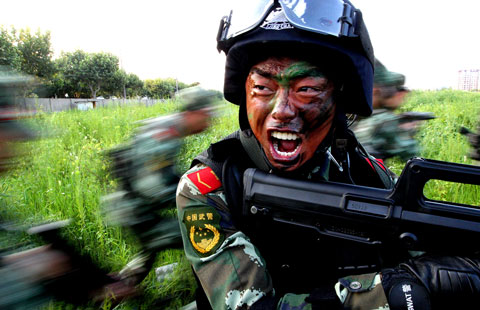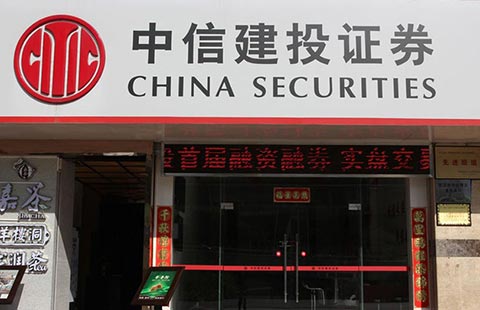
VIII. Right to a Clean and Healthy Environment
Aiming to solve the environmental and ecological problems caused by the country's rapid economic growth, the Chinese government continued to promote ecological progress in 2013, constantly improving environmental protection systems and enhancing environmental management and ecosystem preservation. Focusing on solving the major environmental problems that seriously endanger people's health, it investigated and punished harshly illegal pollution and environmental crimes, so as to safeguard people's right to a healthy and clean environment.
The planning and mechanisms for protecting the environment and ecosystems is being furthered improved. China formulated and implemented a series of policy documents and plans for environmental protection, including the Prevention and Control of Environmental Risks of Chemical Products, during the 12th Five-year Plan Period (2011-2015), Action Plan for Preventing and Controlling Air Pollution, Detailed Rules for the Implementation of the Action Plan for Preventing and Controlling Air Pollution in Beijing, Tianjin, Hebei and the Surrounding Areas, Plan for Monitoring and Early-warning of Heavily Polluted Weather in Beijing, Tianjin, Hebei and the Surrounding Areas, Work Plan for Preventing and Controlling Groundwater Pollution in the North China Plain, Opinions on Strengthening Environmental Protection and Management in Key National Ecological Function Zones, Methods for Assessing the Implementation of the Strictest Management System of Water Resources and Opinions on Accelerating Progress in Water Ecological Systems. With 135 newly issued items in 2013, China had a total of 1,499 items of national criteria for environmental protection currently in effect.
The Ministry of Environmental Protection of China has signed target responsibility agreements for preventing and combating air pollution with 31 provinces (autonomous regions and municipalities directly under the central government). The Chinese government has promoted the building of PM2.5 monitoring stations in key and model cities for environmental protection. It completed the assessment of environmental impacts of the western China development strategy in 2013, and launched the assessment of environmental impacts of the central China development strategies. Limitations on air pollutants were imposed for the thermal power, steel, petrochemical, cement, non-ferrous metal and chemical engineering industries as well as coal-fired boiler projects in key control areas. The Ministry of Environmental Protection and China Insurance Regulatory Commission jointly developed the Guidelines for the Pilot Projects of Compulsory Environmental Pollution Liability Insurance, stipulating that enterprises connected with heavy metals, enterprises that had been insured according to local regulations and other high-environmental-risk enterprises must take out environmental pollution liability insurance. The second stage of experiments in environmental function zoning was launched in ten provinces (autonomous regions), and the experiment for ecological red-line demarcation technology was launched in Inner Mongolia, Jiangxi, Guangxi and Hubei. The state set up an inter-ministry coordination mechanism for preventing and controlling air pollution and a cooperative mechanism for preventing and controlling air pollution in Yangtze River Delta areas and Beijing, Tianjin, Hebei and the surrounding areas. The liability and assessment system for water resources management was put into effect. Inspection teams for the implementation of the strictest management system of water resources was set up in 31 provinces (autonomous regions and municipalities directly under the central government), with the local government head assuming responsibility. The targets of the "three red lines" (for water resources exploitation, water efficiency and pollution in water-related zones) were further divided and assigned. China began devising the Plan of Water Resources Protection, finished the measurement of assimilative capacities of major rivers and lakes, and proposed a phased schedule for emission limitations.
Funds used for environmental protection is being increased. The Chinese government provided some 338.3 billion yuan in 2013 for conserving energy and protecting the environment, seeing a 14.2 percent year-on-year growth. The Plan of Capability Development in Environmental Monitoring during the 12th Five-year Plan Period was drawn up and implemented. The central government put 1.6 billion yuan into a pilot project for protecting the environment and ecosystems of lakes with good water quality. The State Council reviewed and passed the Overall Plan for Protecting the Environment and Ecosystems of Lakes with Good Water Quality (2013-2020). The transfer payment for key ecological function zones reached 42.3 billion yuan, covering 492 counties. The central government also spent 2.5 billion yuan on combating heavy metal pollution, the first portion of five billion yuan used to support air pollution control in Beijing, Tianjin, Hebei, Shanxi, Shandong and Inner Mongolia, and six billion yuan used to improve the comprehensive environment in rural areas.
Environmental protection measures are being furthered enhanced. In 2013 China set up 21 national nature reserves. Some 16 provinces (autonomous regions), including Hainan, Heilongjiang and Anhui, launched the Ecosystem-friendly Province (autonomous region) Project and over 1,000 cities (counties) launched the Ecosystem-friendly City (county) Project, with a total of 55 national-level ecosystem-friendly cities (counties) and 2,986 national-level ecosystem-friendly townships being set up. In addition, 46 cities (districts) launched the Water Ecosystem-friendly City Project. China's urban green areas reached 2,367,842 ha, covering 39.59 percent of the total urban land, with the per capita green area in public parks being 12.26 sq m. When 496 monitoring stations in 74 cities gave real-time updates of monitoring data of six pollutants, including fine particles (PM2.5 particles), a second batch of 116 cities were also building pollutant-monitoring stations and began providing real-time updates. The state deepened the prevention and control of water pollution in key basin areas. In order to strengthen water resources protection in basin areas, it launched the projects to enhance water resources monitoring capacity, established 14,000 national monitoring stations in water-consuming units, water function zones and provincial borders, and achieved online water-quality monitoring in 175 key drinking water source areas, so as to put water quality of over 70 percent of water volumes used with permission, 80 percent of key water function zones and all major inter-provincial and boundary rivers under surveillance. The state formulated the Management Measures of Water Function Zones, enhancing classified and categorized supervision and management. Among 577 water-quality monitoring sections in China's seven major river systems, 66.7 percent of water sections were graded in categories I-III, and 10.8 percent were graded as inferior category V, an increase of 2.6 percentage points and a decrease of 1.5 percentage points, respectively, compared with 2012.
Aiming to prevent and control air pollution, projects of emission-reduction by means of updating facilities are being greatly boosted. The large-scale smog in China's central and eastern areas since 2013 has caused great concern of the public. The State Council issued the Action Plan for Preventing and Controlling Air Pollution in September 2013, imposing 35 concrete measures, including reducing the emission of air contaminants, upgrading the industrial structure, speeding up enterprises' technical transformation, optimizing the energy mix, and applying strict criteria for energy conservation and environmental protection. China established a joint prevention and control system for regional pollution, promptly reacted to severe pollution days, mobilized the whole of society to participate in the actions of maintaining clean air, promoted air pollution control and reduced smog. In 2013 the desulfurization facilities of the active thermal power generating units with a capacity of 34 million kw were retrofitted to increase capacity, and the ratio of generating units with desulfurization facilities came to account for 90 percent of all generating units in China's coal-fired thermal power stations. A capacity of 205 million kw were retrofitted with generating units with NOx reduction facilities in the year, reaching 50 percent of China's total thermal installed capacity. The gas bypass of desulfurization facilities of thermal power generating units with a capacity of 203 million kw was cancelled, with the capacity of desulfurization generating units without gas bypasses accounting for 46 percent of the total thermal power installed capacity. Cement clinker plants with a capacity of 570 million tons were retrofitted with NOx reduction facilities, accounting for 50 percent of the total capacity. The emissions of four major pollutants-organic pollutants (measured by chemical oxygen demand), ammonia nitrogen, sulfur dioxide and NOx-decreased by 2.93 percent, 3.14 percent, 3.48 percent and 4.72 percent, respectively, compared with 2012, with the emission of NOx dropping below the 2010 reduction benchmark for the first time. The daily sewage treatment capacity in towns (including both incorporated towns and industrial parks) increased by 11.94 million tons in 2013, and 84.8 percent of the garbage in cities at all levels was made harmless after treatment.
Specialized environmental-protection inspections are being conducted, and environmental crimes are being cracked down on. Some 1.83 million law-enforcement personnel were sent to inspect 710,000 enterprises in 2013, investigating and dealing with 6,499 cases of environmental violation and illegal activities, and handling 1,523 cases within a set time limit under the supervision of higher authorities. The central government paused project environmental approvals of 16 cities in the provinces that had failed the 2012 examination of the implementation of the Plan for Preventing and Controlling of Heavy Metal Pollution during the 12th Five-year Plan Period. More than 300,000 tons of chromium slag was treated in the year, almost equal the total discharged volume, and 17 batches of solid waste were prevented from illegal entry. The revised Civil Procedure Law, which went into force January 1, 2013, established the environment-related public interest litigation system, stipulating that law-designated governmental organs and organizations can legally challenge activities that damage the public interest, such as those polluting the environment and those infringing consumers' lawful rights and interests. According to the Interpretation of Several Issues Concerning the Application of the Law in the Handling of Criminal Cases of Environmental Pollution jointly issued by the Supreme People's Court and the Supreme People's Procuratorate in June 2013, environmental crimes will be harshly punished, and the environmental regulatory authorities' misprisions in environmental monitoring will be liable to extra punishment. In 2013 public security organs all over China filed 779 environmental cases and roped in 1,265 criminal suspects; people's procuratorates at all levels charged 20,969 suspects with major contamination accidents, illegally mining or illegally felling trees, investigated 1,290 officials for work-related crimes in projects concerning environmental monitoring, pollution control and ecosystems restoration, and required related government departments to fulfil their statutory duty of supervision according to law by means of prosecutorial advice and urging them to bring to light illegal conduct; people's courts at all levels accepted and heard 134 environmental cases, with 104 concluded, and applied criminal sanctions to 139 persons. Moreover, the Supreme People's Court announced such typical cases of environmental-pollution crimes as the Zijin Mining Group's pollution spill at the Zijinshan Gold and Copper Mine, pollution accidents of Chengjiang Jinye Industry and Trade Co., Ltd. in Yunnan, a pollution accident of Yunguang Chemical Industry Co., Ltd. in Chongqing, and the dumping of hazardous substances by Hu Wenbiao and Ding Yuesheng.








